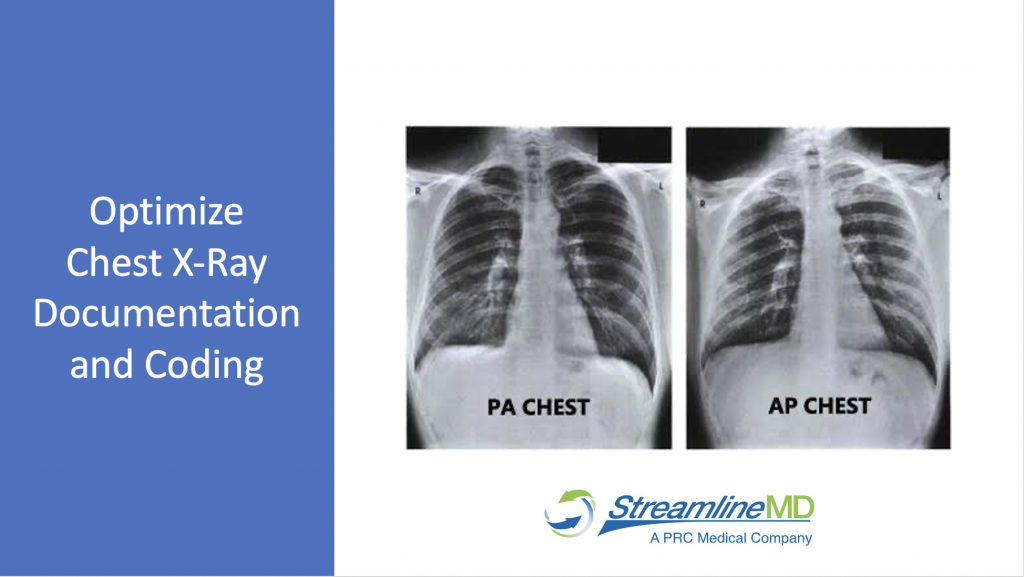Chest x-rays are the most common radiologic tests performed. From a birds-eye view it appears they are easy to document, easy to code, and easy to get reimbursed, but that is not always the case.
The purpose of this article is to show you how the codes differ by the number of views, values, and the number of times a code can assigned for a single date of service. Understanding how they differ will allow you to optimize your Chest X-Ray documentation and coding.
2022 CHEST CPT CODES
| CPT CODES | *RVUs | **MUEs | CODE DESCRIPTION |
| 71045 | .18 | 4 | Radiologic examination, chest, single view |
| 71046 | .22 | 2 | 2 views |
| 71047 | .27 | 1 | 3 views |
| 71048 | .31 | 1 | 4 or more views |
*Relative Value Units (RVUs) are used to support the calculation of physician reimbursements. They are an objective way to identify the cost components linked to procedures described in the Current Procedural Terminology (CPT®) code set. The calculations enable health care professionals to combine the time, intensity, and cost of care into a single relative ranking scale called the Resource-Based Relative Value Scale (RBRVS).
**Medically Unlikely Edits (MUEs) are used by the Medicare Administrative Contractors (MACs), including Durable Medical Equipment (DME) MACs, to reduce the improper payment rate for Part B claims. A MUE for a HCPCS/CPT code is the maximum units of service that a provider would report under most circumstances for a single beneficiary on a single date of service.
CHEST CPT CODES AND DESCRIPTIONS
For chest x-rays, the total number of views documented determines the correct CPT code. Documentation should include the named view(s), such as anteroposterior (AP), posteroanterior (PA), lateral, oblique, and decubitus views. The number of images obtained is different from the number of views. For example, five images of the same view will remain a single view chest.
Certain diagnostic imaging studies include a chest x-ray in the code description. In these cases, the reimbursement of the chest x-ray is already factored into the value of the code.
74022 Radiologic examination, complete acute abdomen series, including 2 or more views of the abdomen (e.g., supine, erect, decubitus, and a single view chest)
71101 Radiologic examination, ribs, unilateral; including posteroanterior chest, minimum of 3 views
71111 Radiologic examination, ribs, bilateral; including posteroanterior chest, minimum if 4 views
Also, another area of confusion is when a chest x-ray is performed in addition to a procedure of which it may be considered to be part. For example, when a chest x-ray is used to either confirm catheter position following a central venous catheter insertion or to confirm proper positioning of a chest tube, the chest x-ray cannot be billed separately. For these cases, chest x-rays are considered to be integral to the procedure. This instruction comes from the current 2022 National Correct Coding Initiative Policy Manual, Chapter 9, Section C.:
“9. When a central venous catheter is inserted, a chest radiologic examination is usually performed to confirm the position of the catheter and absence of pneumothorax. Similarly, when an emergency endotracheal intubation procedure (CPT code 31500), chest tube insertion procedure (e.g., CPT codes 32550, 32551, 32554, 32555), or insertion of a central flow directed catheter procedure (e.g., Swan-Ganz) (CPT code 93503) is performed, a chest radiologic examination is usually performed to confirm the location and proper positioning of the tube or catheter. The chest radiologic examination is integral to the procedures, and the chest radiologic examination (e.g., CPT codes 71045, 71046) shall not be reported separately.”
RELATIVE VALUE UNITS (RVUs)
CPT codes are assigned RVUs which are used as part of the payment formula to determine reimbursement. For chest x-rays, be sure to notice RVUs differ by the number of views. More views equal higher RVUs, which will result in higher reimbursement.
Therefore, to ensure accurate reimbursement, always identify the views by name in your documentation.
MEDICALLY UNLIKELY EDITS (MUEs)
MUEs are used by Medicare Administrative Contractors (MACs) to reduce improper payments. Some commercial insurances also choose to use these edits.
A MUE is assigned to a HCPCS/CPT code. This MUE identifies the maximum number of units of service that a provider can report under most circumstances to a single patient on a single date of service.
For example: If six one-view chest x-rays were done on the same patient on the same date of service, only four one-view chest x-rays will get reimbursed. This is because the MUEs for 71045 Chest, single view are limited to four.
SUMMARY
In summary, Chest x-rays are one of the most common tests performed. As it is with any diagnostic study, the documentation of medical necessity is paramount for every case. Without clear documentation of clinical indications (Clinical Indications Best Practices) and proof of medical necessity, there is no reimbursement. But in addition to medical necessity, it is important to understand how each chest x-ray differs:
- CPT codes for chest x-rays differ by the number of views
- Certain diagnostic imaging studies include a chest x-ray in their code descriptions (e.g., abdominal series, ribs that include a chest x-ray) which means reimbursement for the chest x-ray is factored into the value of the CPT code
- For certain procedures, such as central venous catheter insertions or chest tube placements, the chest x-ray is integral to the procedure and cannot be separately billed
- For clarity, be sure to clearly name each view read (e.g., AP, lateral, oblique)
- Be aware that there are limitations on the number of times a chest x-ray can be reimbursed on a single date of service (MUEs)
References:
CMS National Correct Coding Initiative Program (NCCI) Medicare and Medicaid Program
CPT 2022 Professional Edition
2022 Medicare Physician Fee Schedule




